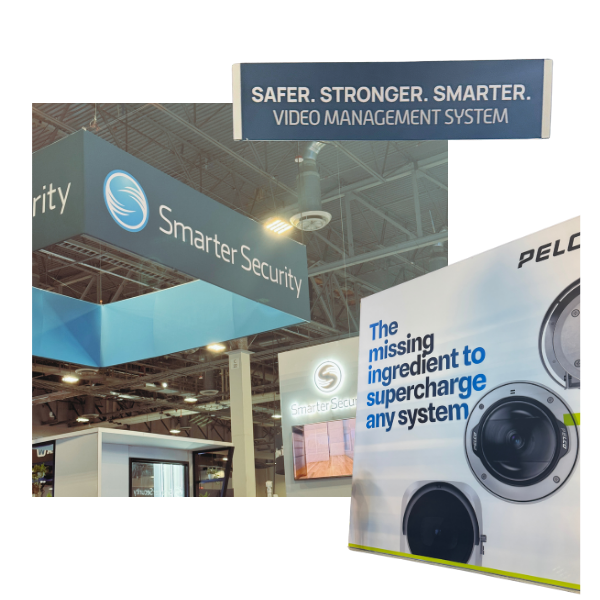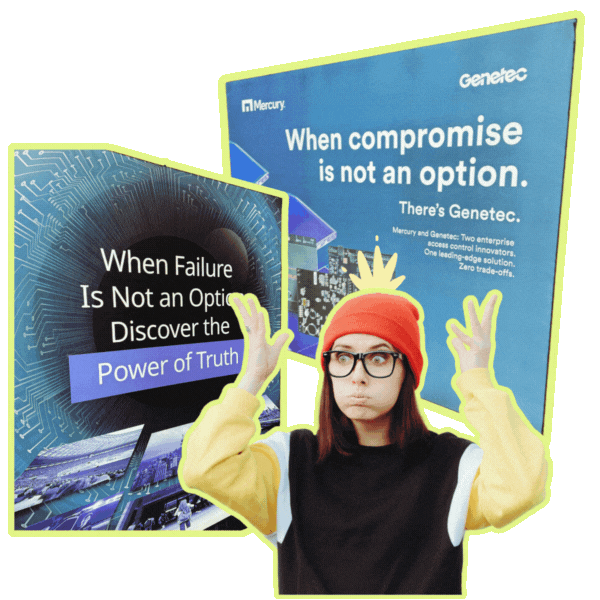What Security Brands got Wrong (and Right) at ISC West 2025
I walked the floor at ISC West this year armed with two things: comfortable shoes and curiosity. And after hours of weaving through booth after booth, I can say with confidence that the security industry doesn’t have a technology problem—it has a messaging problem.
Don’t get me wrong. There’s innovation everywhere. AI, cloud, analytics, edge processing—everyone’s got something cutting-edge to show off.
But if you’re not saying something people can remember three booths later, you’re just noise with a lighting rig.
Here’s what I noticed, what it means, and how to do better.
1. Everyone’s selling “cloud”—no one’s selling clarity
Almost every booth I walked by had some version of the word “cloud” on their backdrop. Cloud-based platform. Hybrid cloud. Cloud-enabled video. Cloud-first analytics.
“Manage from the cloud. Protect what’s below.”
“A Hybrid, Happy Path to Cloud”
“Remote services made easy. Cloud-based Partner Portal”
And yet, when I asked people what made their solution different, most responses boiled down to: “Well, it’s easier to manage remotely.”
Okay—but why does that matter to me?
➜ What pain does it solve?
➜ What’s different about your version of cloud?
➜ What can I do now that I couldn’t before?
Most booths fell into the trap of marketing jargon instead of outcomes. But the strongest brands know that the tech stack is just a means to an end.
Tip: Don’t just tell me it’s in the cloud. Tell me what I can stop worrying about because of it. Maybe if I understand that I will be more willing to fight with IT about how a cloud solution is worth the risks.
2. “Smart” is marketing shorthand for “we didn’t try”
*Actual signage at ISC West
I lost count of how many companies used some variation of “Smarter Security” as their core message.
Rhombus had it with “Smarter Security. Better Business” as their tagline.
Others hinted at it with AI-this and intelligent-that.
On its own, “smart” doesn’t carry weight anymore. It’s the beige paint color of messaging—inoffensive, overused, and utterly forgettable.
I asked one booth rep what made their platform “smart,” and the answer was: “It has facial recognition and analytics.”
Cool story. So does everyone else.
Now contrast that with Pelco’s “Supercharge your security.” That tagline immediately taps into emotion. It’s not about being slightly better—it’s about becoming powerful. And in an industry where end users often see themselves as the last line of defense, that kind of framing lands (but more on that later).
Tip: The word “smart” is a shortcut. Replace it with a specific benefit, emotional payoff, or vivid metaphor that actually differentiates.
3. Seeing tech isn’t the same as experiencing it
One of the most insightful conversations I had at the show was with an integrator who told me they come to ISC not just to network—but to see new tech they haven’t had access to. And yet? After a few hours on the floor, everything blurred.
And they weren’t wrong.
Most booths were stacked with products—screens, cameras, mounts, racks—but after the fifth or sixth version of “next-gen analytics,” it all started to blur.
Another camera. Another sensor. Another black box with a blinking light.
But then there was Verkada.
Verkada didn’t just show their product—they built a world around it. A full-blown escape room where visitors had to use the technology to solve problems. Want to open this door? Use access control. Want to leave the room? Figure out the motion path using their analytics. Each step embedded a feature into the narrative.
It wasn’t just a booth. It was a storyline. And suddenly, the features had context.
You weren’t watching a demo. You were part of it.
Why did it work? Because experience builds memory.
When someone interacts with your product—even briefly—they move further down the buying journey without even realizing it.
They're not just learning—they're living it.
Meanwhile, most other booths went the “show and soak” route:
Big logos, big screens, maybe a looping video if you stood in the right spot.
But there was no tension. No decision-making. No stakes.
Imagine this instead:
A “data breach” challenge where visitors race to lock down a system.
An analytics tool that walks you through a day in the life of a campus operator.
A game where you try to spot suspicious activity using real footage.
Tip
Display tells.
Experience sells.
If your tech is actually good, let people use it—even in a small, gamified, low-stakes way. It’ll do more for your pipeline than another looping highlight reel.
Side note
Don’t come at me about the Theraguns and AirPods.
Yes, I saw them. Yes, I have opinions.
There’s a part of me (the part that didn’t win anything) that knows it was over-the-top, wildly unattainable for most companies, and honestly deserving of a solid eyeroll.
But the other part? Thinks if you’ve got it $200M to burn, you might as well flaunt it.
Just don’t confuse prize envy with brand loyalty. One gets your badge scanned. The other gets you remembered.
4. The superhero complex is real—market to it
Security professionals aren’t just buying software. They’re buying the ability to see more, know more, and respond faster. They’re buying peace of mind for someone else—and responsibility for themselves.
That’s heavy.
It’s why messaging like “Supercharge your security” works so well.
It doesn’t sell a product—it sells a transformation:
You, but upgraded.
You, but with tools that make you the hero in the moment that matters.
Most brands missed this completely.
They listed features, showed screenshots, and recited acronyms.
But no one wants to be sold a dropdown menu. They want to be sold control: power. speed. certainty.
Tip: Don’t just show what your product does. Show how it turns the user into the person everyone relies on when things go sideways.
5. Toss the word salad
Two of the most eye-roll inspiring taglines I saw at ISC West were:
➜ “When compromise is not an option, theres Genetec”
➜ “When failure is not an option, discover the power of truth.”
You know it’s bad when two different companies independently come up with the same vague word salad.
They sound profound until you realize they could be promoting anything from a VPN to a documentary to a new flavor of Gatorade.
Here’s the thing: generic “strength” statements don’t build trust. They confuse people. They tell me nothing about what you actually do, how it works, or why I should care.
Specific, product-driven outcomes? Those do the heavy lifting.
Let’s quickly run through some rewrites.
Instead of “When failure is not an option, discover the power of truth,” try:
“Know more. React faster. Fail less.”
This keeps the original message—that failure isn’t an option—but makes it clear how the product helps prevent failure.
You’re not just being told to trust it.
You’re being shown what it helps you do.
“Because ‘good enough’ gets breached.”
Direct and emotionally charged. It’s a warning—and a positioning statement.
It puts the risk front and center.
If you’re settling for a system that’s just “fine,” you’re opening yourself up to failure.
It makes the cost of doing nothing or not using their product feel real.
“Built for the paranoid. Trusted by the prepared.”
This builds credibility and taps into identity.
If you’re the kind of person who double-checks locks or reads the fine print, this product is speaking your language. It targets people who take their job seriously—and a subtle challenge to those who don’t.
Which one would you choose?
Tip: If your tagline could be used by a gym, law firm, or luxury car brand, start over. Anchor it in something only you can claim.
6. Most brands are afraid to be remembered
Here’s the thing: professionalism is not the same as predictability.
And yet, most booths played it painfully safe.
Corporate blue. Stacked monitors. A tagline that sounds like it was workshopped by a compliance team. There’s an unspoken rule in this industry that you can either be taken seriously or take risks—but never both.
That’s false.
The booths that stood out? They took risks. They were weird. Or clever. Or just... human. One had a cheeky tagline. Another handed out swag that actually got used. Verkada built an escape room.
IPConfigure had some weird posters with half camera half animals.
IPConfigure booth posters at ISC West 2025
A little weirdness goes a long way when everything else is grayscale and gradients.
This made me stop and read the text. It was just bizarre enough to need more context.
It also left an impression and was memorable.
I respect the creativity. Kudos to their marketing team.
Playing it safe might keep you off someone’s “what were they thinking” list.
But it’ll also keep you off their radar.
Tip: Don’t aim to be “professional.” Aim to be unforgettable. You can do both.
So, what should you do instead?
If you want your next trade show—or campaign, or rebrand—to actually land, here’s your cheat sheet:
Focus on outcomes, not buzzwords.
Don’t just say your product is “smart”—say what it notices, solves, or prevents.
Speak to the hero.
Security pros aren’t just buyers—they’re the ones keeping things from going sideways. Position them as the superhero. Your product is the utility belt.
Cut the corporate fluff.
Lose the vague motivational one-liners. Say one thing only you can say. Be clear, not clever-for-clever’s-sake.
Don’t be afraid to be weird.
You don’t need to be loud. You need to be specific. Human. Strategic. Even playful. Especially in an industry that takes itself very seriously.
The bottom line…
Your booth doesn’t have to scream. It just has to make people feel something.
If you're willing to be honest, take creative risks, and treat your buyers like humans—not job titles—you’ll already be ahead of 80% of the floor.
And when your competitors start echoing your brand voice six months later?
That’s good marketing.




